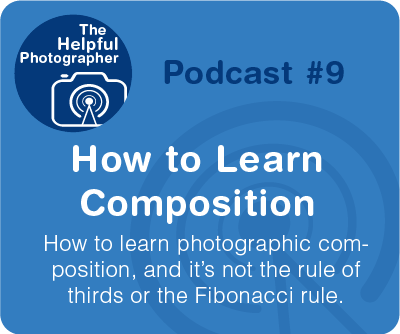Photo Tips Podcast: How to Learn Composition #9

How to Learn Photographic Composition
If you had listened to the trailer for this podcast, you would have heard me say that this podcast series will be about the technical points of photography even though it is less than 1/3 of what we do. So the question is why am I avoiding the composition/creativity discussion? Here’s why. I went to Art Center College of Design in Pasadena, California which is a traditional art school. And personally I think it’s the best school in the country for art and design. I think from that statement you can tell that I am not only biased but incredibly grateful for the education that I got. More than 2/3’s of my education at Art Center did not actually revolve around the technical aspects of photography, it revolved around creativity and art.p We learned how to create great art by bringing our images to class and going through a formal critique, where we listened to our teachers and classmates dissect our work by telling us what worked and what didn’t work. And we had discussions on how to make it better, we talked about our intent and others told us whether or not we succeeded in communicating that intent. Then we would leave the classroom and we would talk about it with each other in the cafeteria, while printing our images in the lab and definitely in the hallways. And then we would leave campus and go hang out at each other’s apartments and discuss it some more. While at Art Center, I also made friends with students studying fine art painting, and graphic design, and transportation design and we would talk about art and design. So it wasn’t just photography for me, it was everything related to art and it was constant. So art and creativity certainly didn’t stop at the classroom door nor did it stop at the campus gates. This is how I learned photography.
And through this process I learned that the best way to grow as an artist is through a community. I find that the problem with photography websites is that they tell you about the rule of thirds and leading lines and they dissect it like a math problem, but great art isn’t painting by numbers, it never has been. I don’t ever remember formally discussing the rule of thirds or leading lines at Art Center; we certainly never discussed the Fibonacci rule. And the reason is because making great art is about having a vision that expresses a feeling or emotion or idea. And no amount of rules can possibly help you do that. I’ve even seen scientific theories on how composition works and although it’s interesting, you can’t tell me that any one of these scientists can pick up a paint brush or camera and make an amazing image with their knowledge of these theories alone. By having this dialog with classmates and teachers I became more clear on how I saw the world and what I wanted my work to express. In other words my own vision became more focused. And the technical education I received at Art Center? That’s what gave me the skills to express my ideas. But without all of the discussions and arguments, I don’t think my work would be where it is today. As a matter of fact, my work looks very different than it did 20 years ago. It even looks different from what it did 5 years ago. As my view of the world changes, so does my work.
As artists, I think it’s important to keep in mind that that art is about sharing a vision. And the operative word here is share. That’s why we post them facebook and Instagram and on our walls. We want people to see this work. If you are truly doing the work only for yourself then it should go no further than your studio. In essence, the act of sharing our images is about the attempt to communicate something with an audience and unless we have a dialog with others, we will never know whether or not it’s accomplishing that goal. Having said this, I am also fully aware that as an artist, it is exceedingly rare that you get to have these kinds of discussions with an audience, and that you cannot control what every viewer is thinking; and each viewer definitely brings with them their own bias and baggage for that matter. But never having these types of discussions means that you only ever operate within your own box and therefore never expand your own vision. And this is why this podcast will not concentrate on composition or creativity because it’s a monologue when it’s supposed to be a dialogue. And that’s why we created NYC Photo Safari. When you come out on a safari with me or with one of the other guys, you get to have this conversation as you create your photos. We can discuss with you what we think works or doesn’t work right on the spot.
In the next two podcast I will talk about how to find inspiration for your photos and and how you might want to think about your images as you begin to the next steps towards getting your images to the next level. And I will admit that they will be fairly abstract discussions with no visual aids.
I know that was a little bit anti-climatic but I hope it was helpful.
